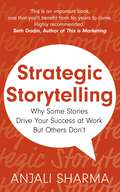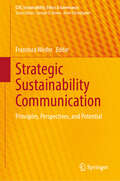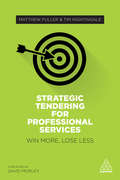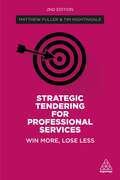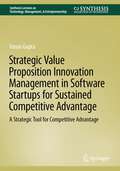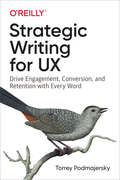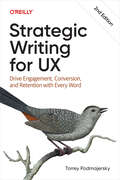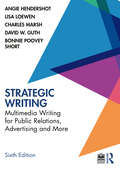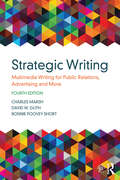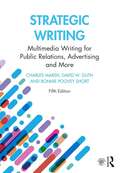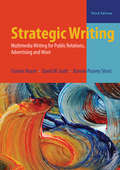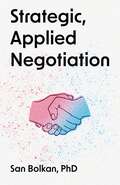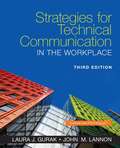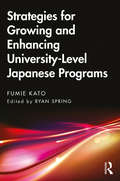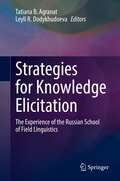- Table View
- List View
Strategic Storytelling: Why Some Stories Drive Your Success at Work But Others Don’t
by Anjali SharmaIn today's connection economy, the most successful leaders inspire their people with purpose and meaning. Powerful corporate storytelling can mobilise people around an organisational objective in a way that a focus on market share never will. Be it a digital transformation or a diversity and inclusion initiative, corporate change needs the support of the people in that organisation in order to stick.Yet, while all stories can move people to take action, storytelling isn't a one size fits all. The most effective influencers learn to flex their narrative based on the audience's time or their level of expertise.A story that works on the stage doesn't work in the boardroomA story that works in the boardroom doesn't work in a team meetingA story that works in a team meeting doesn't work in a one-to-one conversation A story that works in one-to-one conversation doesn't work in sales...Anjali Sharma introduces leaders and ambitious influencers to the Who, Why and How of strategic storytelling in business, enabling them bring about change and drive corporate success by telling exactly the right story in the right way.
Strategic Sustainability Communication: Principles, Perspectives, and Potential (CSR, Sustainability, Ethics & Governance)
by Franzisca WederThis book discusses the evolution of the sustainability story in corporate, political, and environmental discourses as well as paradigms and theoretical approaches to better understand communication about, of, and for sustainability. The book aims to be a preferred resource for academics, scholars, students as well as practitioners in environmental management, communication management, journalism as well as sustainability studies. The authors elaborate on various conceptual perspectives on strategic sustainability communication and offer practical examples and exercises for making sustainability and related issues accessible and comprehensible, for co-creating social change and taking authorship in new emerging professions like Sustainability Manager and Officer. Furthermore, the volume explores methodological as well as pedagogical innovations, complemented by case studies and interviews around existing strategies and tactics to create sustainable solutions (communication planning, campaigning, messaging, etc.). Thus, it offers students and instructors as well as (future) communication strategists and campaigners foundations, strategies, tools, and methodologies of communication for transformation and co-creation of alternative narratives. Professionals, advocates, and academics are attracted who are passionate about taking proactive roles in restoratively addressing the pressing interrelated sociocultural and ecological issues of our times and seek to be reflexive leaders and advocates.
Strategic Tendering for Professional Services: Win More, Lose Less
by Matthew Fuller Tim NightingaleCompetitive bidding for work is a long-established aspect of business within the professional services and consulting sector. For many markets, pitching has become a critical element of both attracting and retaining business. Combating clients' demands and intense competition, firms that want to win and retain business need business development and marketing teams that are experts in creating compelling proposals. Strategic Tendering for Professional Services offers a masterclass in improving your pitching skills and processes.Drawing on insights from current pitch and proposal professionals and client-side procurement teams, Strategic Tendering for Professional Services provides end-to-end best practice guidance. From the crucial decision of which request-for-proposals (RFPs) to respond to, right through to the all-important face-to-face presentation and post-pitch follow-up, this practical handbook leads readers through all stages of the process on best practice and strategies for success. Packed with practical features to help readers put guidance into practice, Strategic Tendering for Professional Services also supports business-wide improvement with a clear analysis of the processes and systems available to support pitch assembly and reporting. Whether you are a bid and proposal professional looking for extra tools, a business development or marketing manager providing support and expertise to partners, or a professional wanting to improve pitching skills, this book will be key to winning opportunities that will set the firm apart.
Strategic Tendering for Professional Services: Win More, Lose Less
by Matthew Fuller Tim NightingaleWINNER: Business Book Awards 2018 - 'Selling The Dream' category (1st edition)In an increasingly competitive professional services sector, it is vital that firms have an effective tendering strategy. The advantages gained from winning and retaining clients can be transformative, and the cost of losing key tenders can be catastrophic. Strategic Tendering for Professional Services provides end-to-end best practice guidance, from the crucial decision of which request-for-proposals to respond to, right through to the all important face-to-face presentation and post-pitch follow-up. Now in its second edition, this practical book captures insights from both sides of the market through interviews with both proposal professionals and decision makers from the client side. Focusing on key considerations, including the need for diversity and inclusion, providing evidence of global citizenship and how public sector pitching differs from the private sector, this book is packed with features and tools to help professionals turn guidance into practice. Strategic Tendering for Professional Services is the essential guide to improving your pitches, honing your tendering skills and boosting your win rate.
Strategic Value Proposition Innovation Management in Software Startups for Sustained Competitive Advantage: A Strategic Tool for Competitive Advantage (Synthesis Lectures on Technology, Management, & Entrepreneurship)
by Varun GuptaThis book aims to increase the success rates of startups by focusing on value proposition innovation, which is propelled by the involvement of potential consumers as well as other resources such as freelancers and strategic relationships with academia. The author shows how startups who are resource constrained can invest efforts exploring the potential market of their products. The author also explores how global markets can be beneficial for a startup’s success, while showing the workarounds in hard-to-access markets. The book investigates gaining knowledge shared by freelancers, customers, and academia, whose involvement can be crucial in supporting value proposition innovation activities such as ideas generation, implementation, and commercialization. Combined, the author leads readers to discover their ability to foster value proposition innovations that result into long term competitive advantage in a highly fluctuating business environment.
Strategic Writing for UX: Drive Engagement, Conversion, and Retention with Every Word
by Torrey PodmajerskyWhen you depend on users to perform specific actions—like buying tickets, playing a game, or riding public transit—well-placed words are most effective. But how do you choose the right words? And how do you know if they work? With this practical book, you’ll learn how to write strategically for UX, using tools to build foundational pieces for UI text and UX voice strategy.UX content strategist Torrey Podmajersky provides strategies for converting, engaging, supporting, and re-attracting users. You’ll use frameworks and patterns for content, methods to measure the content’s effectiveness, and processes to create the collaboration necessary for success. You’ll also structure your voice throughout so that the brand is easily recognizable to its audience.Learn how UX content works with the software development lifecycleUse a framework to align the UX content with product principlesExplore content-first design to root UX text in conversationLearn how UX text patterns work with different voicesProduce text that’s purposeful, concise, conversational, and clear
Strategic Writing for UX: Drive Engagement, Conversion, and Retention with Every Word
by Torrey PodmajerskyWhen you depend on users to perform specific actions—like buying tickets, playing a game, or riding public transit—well-placed words are most effective. But how do you choose the right words? And how do you know if they work? With this practical book, you'll learn how to write strategically for UX, using tools to build foundational pieces for UI text and UX voice strategy. This second edition by Torrey Podmajersky is an essential resource, thoroughly updated to incorporate the latest in collaborative tools and considerations for AI-generated UX content. It reflects significant advancements in the field of content design, updating every chapter with the latest UX methods and styles. Understand the integration of UX content with the software development lifecycle Learn content-first design to anchor UX text in meaningful dialogue Apply UX text patterns effectively across varied brand voices Enhance product usability and conversion with strategic UI text applications Clearly articulate the business value of dedicated UX content efforts
Strategic Writing: Multimedia Writing for Public Relations, Advertising and More
by Charles Marsh David W. Guth Bonnie Poovey Short Angie Hendershot Lisa LoewenFeaturing examples of strategic writing throughout the book, this practical, multidisciplinary text takes students through the fundamental concepts, genres, and techniques of writing for strategic communicators to connect with their publics. The book contains concise instructions for writing the key multimedia documents in strategic communication, each with an example in the text. Short, practice-oriented chapters each cover a key theme, principle or writing topic. This sixth edition features: new and more diverse examples; additional references on legal and ethical guidance, technical tools and other resources used by practicing professionals; a new Audience Persona chapter; and incorporation of digital trends, such as increased use of images, video and user-generated content as well as evolutions in mobile marketing and other emerging platforms. Strategic Writing, Sixth Edition is an essential textbook for undergraduate courses in public relations, advertising and strategic communication writing, particularly those that take a multidisciplinary approach. Online resources are also included to support instructors and students. Faculty will find sample assignments with rubrics and lecture slides. Students will find practice quizzes for each section; nine-step strategic writing process guidance with helpful links for each step; and examples, templates and online articles demonstrating strategic writing in practice. Please visit www.routledge.com/cw/hendershot.
Strategic Writing: Multimedia Writing for Public Relations, Advertising and More
by Charles Marsh David W. Guth Bonnie Poovey ShortIn its fourth edition, Strategic Writing emphasizes the goal-oriented mission of high-quality public relations and media writing with clear, concise instructions for more than 40 types of documents. This multidisciplinary text covers writing for public relations, advertising, sales and marketing, and business communication. In addition, it includes concise chapters on topics such as diversity, ethics and the legal aspects of strategic writing. Featuring a spiral binding, examples for each document and a user-friendly "recipe" approach, Strategic Writing is ideal for undergraduate PR or advertising writing classes that take an interdisciplinary approach. This new edition devotes new attention throughout to social media and writing in the digital realm, and features new and updated online resources for students and instructors.
Strategic Writing: Multimedia Writing for Public Relations, Advertising and More
by Charles Marsh David W. Guth Bonnie Poovey ShortThis practical, multidisciplinary text teaches high-quality public relations and media writing with clear, concise instructions for more than 40 types of documents. <p><p>Strategic Writing takes a reader-friendly "recipe" approach to writing in public relations, advertising, sales and marketing, and other business communication contexts, illustrated with examples of each type of document. With concise chapters on topics such as ethical and legal aspects of strategic writing, including diversity and inclusion, this thoroughly updated fifth edition also includes additional document samples and coverage of writing for various social media platforms. Packed with pedagogical resources, Strategic Writing offers instructors a complete, ready-to-use course. <p><p>It is an essential and adaptable textbook for undergraduate courses in public relations, advertising and strategic communication writing, particularly those that take a multidisciplinary and multimedia approach. <p><p>Strategic Writing is ideally suited for online courses. In addition to syllabi for both online and traditional courses, the instructor’s manual includes Tips for Teaching Strategic Writing Online. Those tips include easy guidelines for converting the book’s PowerPoint slides to videos with voiceovers for online lectures. The book’s recipe-with-examples approach enhances student self-instruction, particularly when combined with the companion website’s sample assignments and grading rubrics for every document.
Strategic Writing: Multimedia Writing for Public Relations, Advertising, and More
by Charles Marsh David W. Guth Bonnie Poovey ShortIn its third edition, Strategic Writing emphasizes the strategic, goal-oriented mission of high-quality media and public relations writing with clear, concise instructions for more than 40 types of documents. This multidisciplinary text covers writing for public relations, advertising, sales and marketing, and business communication. Featuring a spiral binding, numerous examples and a user-friendly "recipe" approach, Strategic Writing is ideal for public relations writing classes that include documents from other disciplines.
Strategic, Applied Negotiation
by Phd San BolkanIn Strategic, Applied Negotiation, San Bolkan takes an evidence-based approach to helping readers improve their negotiation skills while providing clear and practical advice. He dedicates chapters to topics including Power in Negotiation, Opening Offers, Making Concessions, and Handling Questionable Tactics to give readers a comprehensive look at bargaining with others.
Strategies For Technical Communication In The Workplace (Third Edition)
by Laura J. Gurak John M. LannonBased on the acclaimed Technical Communication by Lannon and Gurak, Strategies for Technical Communication in the Workplace, Third Edition prepares students for workplace writing through a clear and concise writing style, useful checklists, practical applications, numerous sample documents, and coverage of technology and global issues. <P><P>The third edition addresses changing technology in the workplace with a complete chapter on social media, updated examples, and sample documents. This brief and affordable text is accessible to students of all writing levels.
Strategies for Growing and Enhancing University-Level Japanese Programs
by Fumie KatoStrategies for Growing and Enhancing University-Level Japanese Programs offers foreign language program managers and directors, as well as teachers of less commonly taught languages, the insights and proven practical actions they can take to enhance and grow their language programs. Using the Japanese program at UNC Charlotte as the primary case study, author Fumie Kato provides step-by-step instructions on how she grew the Japanese program there from 133 students per semester in 2002 to 515 students per semester in 2017; from a program with just one full-time professor and one part-time faculty member, to a faculty of seven full-time and three part-time members. While Japanese is the example used in the book, the principles can be applied by anyone managing foreign language/less commonly taught language programs who wishes to expand their program and raise their students’ success rates. The book is therefore of interest to instructors, coordinators and directors of foreign language education programs throughout the world.
Strategies for Knowledge Elicitation: The Experience of the Russian School of Field Linguistics
by Tatiana B. Agranat Leyli R. DodykhudoevaThis volume provides an overview of experimental methods, approaches, and techniques used by field linguists of the Russian school, and highlights the fieldwork experience of Russian scholars working in regions with a range of languages that differ genetically, typologically, and in the degree of their preservation.The collection presents language and sociolinguistic data relating to fieldwork in diverse languages: Uralic, Altaic, Paleo-Siberian, Yeniseian, Indo-European Iranian, Vietic, Kra-Day, and Mayan languages, as well as pidgin.The authors highlight the fieldwork techniques they use, and the principles underlying them.The volume’s multidisciplinary approach covers linguistic, ethnolinguistic, sociolinguistic, educational, and ethnocultural issues. The authors explore problems associated with the study of minority languages and indicate diverse and creative techniques for data elicitation. Close collaboration with speakers lies at the core of their approach. The collection presents strategies for eliciting systems of knowledge from mother-tongue speakers, triggering linguistic self-awareness, and providing semantic and morphosyntactic context for their languages.This publication is intended for academics, and for specialists in the field of linguistics and minority and indigenous languages. It will also benefit students as a guide to field research, as well as language activists, interested in documenting and preserving their mother tongue.
Strategies for Media Reform: International Perspectives (Donald McGannon Communication Research Center's Everett C. Parker Book Series)
by Jonathan A. Obar Cheryl Martens Robert W. McChesneyMedia reform plays an increasingly important role in the struggle for social justice. As battles are fought over the future of investigative journalism, media ownership, spectrum management, speech rights, broadband access, network neutrality, the surveillance apparatus, and digital literacy, what effective strategies can be used in the pursuit of effective media reform?Prepared by thirty-three scholars and activists from more than twenty-five countries, Strategies for Media Reform focuses on theorizing media democratization and evaluating specific projects for media reform. This edited collection of articles offers readers the opportunity to reflect on the prospects for and challenges facing campaigns for media reform and gathers significant examples of theory, advocacy, and activism from multinational perspectives.
Strategies in E-Business
by Ignacio Gil-Pechuán Daniel Palacios-Marqués Marta Peris Peris-Ortiz Eduardo Vendrell Cesar Ferri-RamirezIn this volume, the authors apply insights from a variety of perspectives to explore the alignment among strategy, organization design, process and human resource management, and e-business practices on developing successful social networking programs--with particular regard to applying such initiatives against the backdrop of the global financial crisis and challenges to traditional business models. Showcasing in-depth case studies, the authors present emerging approaches to analyze the impact of investment in social networking sites, aligning internal resources, and measuring effects on positioning, branding, and new business creation. The fact that a growing proportion of the world population has a relationship with social networking sites could prove very valuable for companies. The question is whether this represents a business opportunity, whether companies know how to make the most of it and if they will make the necessary efforts to adapt to these new platforms. In the modern world, social networking sites have enormous potential for large as well as small and medium-sized enterprises (SMEs); most companies are aware of the need for a presence on social networking sites, but at present their e-business strategies are part of their medium and long-term strategic planning and only a small percentage have been put into practice. In short, this book attempts to answer the following questions: Is there a business opportunity for companies on social networking sites? Do they know how to make the most of it? Are they willing to make the necessary effort to adapt? Can e-business strategies contribute to company creation and the success of already existing businesses? And if so, how?
Strategische Bildkommunikation: Über den Zusammenhang von psychologischen Kundenprofilen und Bildpräferenz (Schriftenreihe der Kalaidos Fachhochschule Schweiz)
by Yannik BrandenbergerIn einer sich rasant verändernden Marketinglandschaft wird die Bedeutung einer authentischen Verbindung zwischen Unternehmen und Konsumenten immer dringlicher. Statt mit Inhalten zu überfluten, liegt die Herausforderung darin, durch gezielte visuelle Kommunikation eine tiefere Bindung aufzubauen. Diese Herausforderung wird besonders in der fehlenden Anpassung von Bildern an die psychologischen Profile der Zielgruppe deutlich, für die bisher kein empirisch validiertes Modell existiert. In diesem Buch wird ein tiefer Einblick in den Zusammenhang zwischen psychologischen Kundenprofilen und Bildpräferenzen durch die Untersuchung und Weiterentwicklung des EIC-Modells gewonnen. Die empirischen Ergebnisse, gewonnen aus einer Studie mit 95 Teilnehmenden, bestätigen diese Verbindung und eröffnen neue Perspektiven für die strategische Bildkommunikation. Als Resultat dieser Forschung präsentiert sich das ICS-Modell – ein Instrument, das Fotograf*innen und Marketingexpert*innen befähigt, die Bildkommunikation gezielt auf Zielgruppen auszurichten. Dieses Buch bietet nicht nur einen Einblick in die theoretischen Grundlagen, es regt auch dazu an, wie diese Erkenntnisse in der Praxis für eine wirkungsvolle visuelle Kommunikation genutzt werden können.
Strategische CEO-Haltungskommunikation: Entwicklung und Validierung eines Managementtools für Kommunikationsverantwortliche (BestMasters)
by Marwin BayerAngesichts einer Zeit, die von Komplexität, Uneinigkeit und Polykrisen geprägt scheint, stehen Unternehmen und Chief Executive Officers (CEOs) vor der herausfordernden Aufgabe, ihre ökonomischen Interessen mit den vielfältigen Ansprüchen ihrer Stakeholder in Einklang zu bringen, um den Unternehmenserfolg zu sichern. Speziell zu gesellschaftlich kontrovers diskutierten Themen wächst der Druck auf CEOs, sich eindeutig zu positionieren und dadurch ‚Haltung‘ zu zeigen. Diese Dynamiken begründen ein neues Handlungsfeld innerhalb der Unternehmenskommunikation und des Kommunikationsmanagements als strategischen Partner der Unternehmensführung, welches bislang nur unzureichend erschlossen wurde. Das vorliegende Buch nimmt sich diesem forschungstheoretischen und unternehmenspraktischen Handlungsbedarf an, indem es einen neuartigen Ansatz für ‚Strategische CEO-Haltungskommunikation‘ entwickelt, empirisch validiert und durch ein Managementtool für Kommunikationsverantwortliche nutzbar macht.
Strategische Onlinekommunikation
by Olaf Hoffjann Thomas PleilOnlinekommunikation und speziel Social Media sind als besonders wichtige Herausforderungen des Kommunikationsmanagements erkannt. Kaum ein Unternehmen verzichtet mittlerweile auf die Beobachtung von Diskussionen im Internet und die Umsetzung eigener Kommunikationsstrategien im Social Web. Dort verändern sich für die PR und die Organisationskommunikation zentrale Aspekte: Öffentlichkeiten können heute sehr viel schneller entstehen. Es sind neue Formen der Meinungsbildung zu beobachten, die zunehmend weniger den Mechanismen der Massenkommunikation folgen, sondern Ergebnis netzwerkartiger Prozesse sind. In diesem Umfeld entstehen gleichzeitig neue Formen der Beteiligung, die durch entsprechende niederschwellige Instrumente im Internet erst ermöglicht werden. Aus Organisationssicht verändern sich damit unter anderem Entstehung und Pflege von Reputation oder das Management von Stakeholderbeziehungen. Zehn Jahre nach Beginn der Fachdiskussion zu PR und sozialen Medien gibt dieser Band auf Basis aktueller Untersuchungen Einblick in die Praxis und in aktuelle Herausforderungen der Organisationskommunikation im Internet.
Strategische Wahrheiten: Desinformation und Postfakten in der strategischen Kommunikation
by Olaf Hoffjann Lucas Seeber Ina von der WenseStrategische Kommunikation zielt mit ihren kontingenten Wirklichkeitsbeschreibungen seit jeher auf gesellschaftliche Wahrheitsmodelle. Wie häufig gesellschaftliche Wahrheitsmodelle auf strategische Kommunikationsbemühungen zurückgehen, auf Unwahrhaftigkeit beruhen und damit zumindest zeitweise zu strategischen Wahrheiten werden, zeigen eindrucksvoll zwischenzeitlich geglaubte Wahrheiten, die sich als Lüge entpuppt haben: von Walter Ulbrichts „Niemand hat die Absicht, eine Mauer zu errichten“ über Hitlers Tagebücher bis hin zu den Massenvernichtungswaffen im Irak. Die erfolgreichen Kampagnen der Brexiteers und von Donald Trump 2016 haben diesem Thema zu neuer und bislang ungeahnter Aufmerksamkeit verholfen. Während die Themen Desinformation und postfaktische Gesellschaft die Journalismus-, politische Kommunikations- und Medienethikforschung aktuell zu dominieren scheinen, ist das Schweigen der deutschsprachigen und internationalen PR- und Organisationskommunikationsforschung auffällig. Dies ist umso bemerkenswerter, weil die PR-Wissenschaft in der Vergangenheit immer wieder versucht hat, ihren Gegenstand zu schärfen, indem sie sich am Begriff der Propaganda abgearbeitet hat. Daraus müsste eigentlich eine Affinität für das Thema Desinformation resultieren. Aber genau das Gegenteil ist offensichtlich der Fall: Hat sich die PR-Wissenschaft gerade deshalb nicht mit Desinformation beschäftigt, weil sie sich so dezidiert von Propaganda und darin eingeschlossenen desinformierenden und manipulativen Techniken abgrenzen will? Was sind die Gründe hierfür? Glauben wir, bereits alles zum Thema gesagt zu haben? Liegt dies daran, dass sich die PR- und Organisationskommunikationsforschung seit jeher vor allem für Unternehmen und weniger für politische und Non-Profit-Organisationen interessiert? Oder fühlen wir uns hier schlicht und ergreifend nicht zuständig? Es scheint offenkundig höchste Zeit zu sein, sich wieder eingehend mit Fragen der Desinformation aus der Perspektive der strategischen Kommunikationsforschung zu befassen. Die Beiträge des Tagungsbandes fokussieren hierzu auf neue theoretische Perspektiven, normative Bewertungen und empirische Befunde.
Strategisches Wertversprechen, Innovationsmanagement in Software-Startups für anhaltenden Wettbewerbsvorteil: Ein strategisches Instrument für Wettbewerbsvorteile
by Varun GuptaDieses Buch hat zum Ziel, die Erfolgsquoten von Startups zu erhöhen, indem es sich auf die Innovation des Wertversprechens konzentriert. Dies wird vorangetrieben durch die Einbindung potenzieller Verbraucher sowie anderer Ressourcen wie Freiberufler und strategischer Partnerschaften mit der Akademie. Der Autor zeigt, wie Startups, die in Bezug auf Ressourcen eingeschränkt sind, Anstrengungen unternehmen können, um das Potenzial ihres Produktmarktes zu erkunden. Dabei wird auch untersucht, wie globale Märkte für den Erfolg eines Startups vorteilhaft sein können, während gleichzeitig Lösungen für schwer zugängliche Märkte aufgezeigt werden. Das Buch untersucht das Gewinnen von Wissen, das von Freiberuflern, Kunden und der Akademie geteilt wird, deren Beteiligung entscheidend sein kann, um Aktivitäten der Wertversprechen-Innovation wie Ideenentwicklung, Umsetzung und Vermarktung zu unterstützen. In Kombination führt der Autor die Leser dazu, ihre Fähigkeit zu entdecken, Wertversprechen-Innovationen zu fördern, die langfristige Wettbewerbsvorteile in einer stark schwankenden Geschäftsumgebung zur Folge haben.
Streaming Wars: How Getting Everything We Wanted Changed Entertainment Forever
by Charlotte HenryStreaming broadcasters have given consumers all the content they could ever want. But at what cost?In Streaming Wars, journalist Charlotte Henry explores the seismic shifts behind the rise of platforms like Netflix, Disney+, Apple TV+, Spotify, Amazon Prime, Paramount and more. From Hollywood's 2023 strikes to the race for sports rights, the growth of ad-supported tiers and the decline of traditional TV, she reveals how streaming has disrupted not only media economics, but also the power structures that define what gets made and who gets seen.As AI, rebundling and fierce competition drive a new phase in the streaming era, Streaming Wars offers a sharp, accessible look at what's next for companies, creators and audiences alike. Whether you're a casual viewer or a media professional, Streaming Wars is your essential guide to the business battles transforming entertainment.
Streaming and Digital Media: Understanding the Business and Technology (Nab Executive Technology Briefings Ser.)
by Dan RayburnSteaming and Digital Media gives you a concise and direct analysis to understand a scalable, profitable venture, as well as the common and hidden pitfalls to avoid in your business. By focusing on both the business implications and technical differences between online video and traditional broadcast distribution, you will learn how to gain significant time-to-market and cost-saving advantages by effectively using streaming and digital media technologies. As part of the NAB Executive Technology Briefing series, the book is geared towards the manager or executive and no technical prerequisite is required. You can quickly learn the technical speak as well as the market and business implications.New In The Book: - Consumer generated content and portals- Distribution of full-length video content- New distribution outlets for delivering content (Sling, TiVO, IPTV)- Addition of Flash streaming technology and Podcasting- Up-to-date market research and data- New industry pricing data
Streamlit for Data Science: Create interactive data apps in Python
by Tyler RichardsAn easy-to-follow and comprehensive guide to creating data apps with Streamlit, including how-to guides for working with cloud data warehouses like Snowflake, using pretrained Hugging Face and OpenAI models, and creating apps for job interviews.Key FeaturesCreate machine learning apps with random forest, Hugging Face, and GPT-3.5 turbo modelsGain an insight into how experts harness Streamlit with in-depth interviews with Streamlit power usersDiscover the full range of Streamlit’s capabilities via hands-on exercises to effortlessly create and deploy well-designed appsBook DescriptionIf you work with data in Python and are looking to create data apps that showcase ML models and make beautiful interactive visualizations, then this is the ideal book for you. Streamlit for Data Science, Second Edition, shows you how to create and deploy data apps quickly, all within Python. This helps you create prototypes in hours instead of days! Written by a prolific Streamlit user and senior data scientist at Snowflake, this fully updated second edition builds on the practical nature of the previous edition with exciting updates, including connecting Streamlit to data warehouses like Snowflake, integrating Hugging Face and OpenAI models into your apps, and connecting and building apps on top of Streamlit databases. Plus, there is a totally updated code repository on GitHub to help you practice your newfound skills. You'll start your journey with the fundamentals of Streamlit and gradually build on this foundation by working with machine learning models and producing high-quality interactive apps. The practical examples of both personal data projects and work-related data-focused web applications will help you get to grips with more challenging topics such as Streamlit Components, beautifying your apps, and quick deployment. By the end of this book, you'll be able to create dynamic web apps in Streamlit quickly and effortlessly.What you will learnSet up your first development environment and create a basic Streamlit app from scratchCreate dynamic visualizations using built-in and imported Python librariesDiscover strategies for creating and deploying machine learning models in StreamlitDeploy Streamlit apps with Streamlit Community Cloud, Hugging Face Spaces, and HerokuIntegrate Streamlit with Hugging Face, OpenAI, and SnowflakeBeautify Streamlit apps using themes and componentsImplement best practices for prototyping your data science work with StreamlitWho this book is forThis book is for data scientists and machine learning enthusiasts who want to get started with creating data apps in Streamlit. It is terrific for junior data scientists looking to gain some valuable new skills in a specific and actionable fashion and is also a great resource for senior data scientists looking for a comprehensive overview of the library and how people use it. Prior knowledge of Python programming is a must, and you’ll get the most out of this book if you’ve used Python libraries like Pandas and NumPy in the past.
